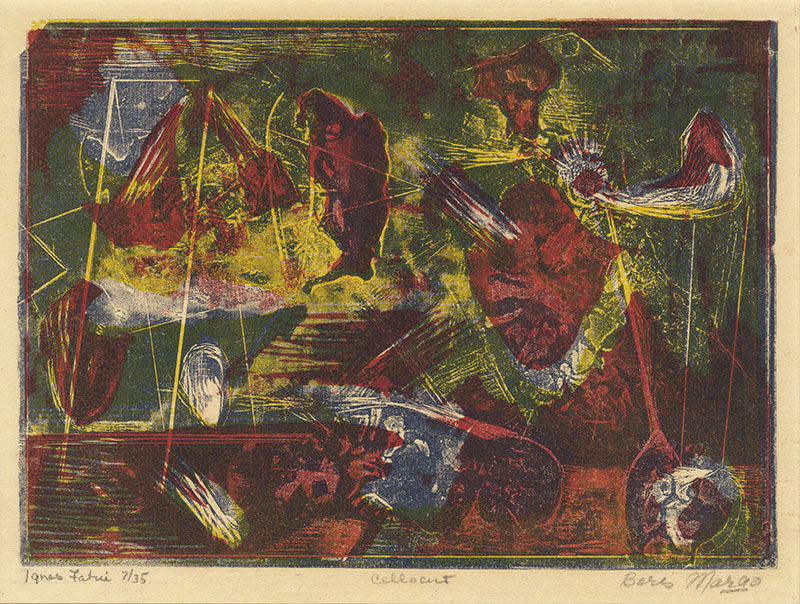Ignes Fatui is a color cellocut from 1945 by Ukrainian-born, American artist Boris Margo. In the collection of the Amon Carter Museum of American Art is Margo’s Portfolio No. 1 from 1934 (1990.23.1-.14), containing cellocuts and etchings. Ignes Fatul is listed as number three on the table of contents created in etching by the artist. This title is also listed as number 26 in Boris Margo Graphic Works: 1932-1968 by Jan Gelb and Alexandra Schmeckebier. Ignes Fatul is pencil signed, titled, and editioned 7/35, and was printed by the artist on cream laid paper. The image measures 7-1/8 x 9-7/8 inches. We have found no explanation as to the source of the conflicting dates in the documentation of Margo’s prints.
Ignes fatui is the plural noun for ignis fatuus which translates to a will-o’-the-wisp, or something deceptive or deluding. Margo created the introductory page for Portfolio No. 1 in etching as he did the table of contents. In his introduction, Margo explains: I believe that the art of our time must embody new content, as well as new form and new techniques. With these three elements present, one can express, through images without logical or factual meaning, all the agony, joy and hope of our age. / For this portfolio I have chosen prints made in each of the three periods into which my work of the last ten years seems to divide, the earliest group is “Destruction,” the next “Rebirth,” and the most recent, “Construction.” / The terror and gloom of the first few prints, the release and joy expressed by the middle group, the hope and fear of present-day Science felt in the most recent prints, are to me the essence of our time.
Boris Margo, inventor, painter, sculptor, and printmaker, was born Boris Margolis on 7 November 1902 in the small, western Ukrainian town of Volochys'k. He studied at the Polytechnik of Art in Odessa from 1918 to 1923. The following year, in Moscow, he participated in the Workshop for the Art of the Future known as Futemas and, between 1927 and 1929, he studied in Leningrad, first at the Hermitage and then with the cubist/surrealist painter Pavel Filinov at the Analytical School of Art. In 1928, with the permission of the Soviet government to study abroad, Margo traveled to Montreal where he worked as a muralist before immigrating to the United States in 1930. He began studying at the Roerich Museum and two years later was teaching there.
In 1931, Margo began experimenting with celluloid and developed the cellocut, a new approach to printmaking. He dissolved sheets of celluloid into a viscous liquid that he poured onto masonite and then worked the hardened surface with printmaking tools.
Margo married Jan Gelb in 1941 and became an American citizen in 1943. He joined the stable of artists with the Betty Parsons Gallery in New York in 1947 and that same year his works were included in the exhibition of Abstract and Surrealists American Art at Peggy Guggenheim's Art of The Century Gallery, and he won the first of many purchase awards from the Brooklyn Museum. He was visiting artist at the American University in Washington, D.C. in 1946 and, in the late 1950s, he was visiting professor for two years at the School of the Art Institute of Chicago. In 1988 a retrospective exhibition of his work was mounted at the Provincetown Art Association.
Boris Margo’s work is represented in the collections of the Brooklyn Museum, New York; the Albert-Knox Art Gallery, Buffalo, New York; the Harvard Art Museums, Fogg Museum, Cambridge, Massachusetts; the Art Institute of Chicago, Illinois; the Detroit Institute Arts, Michigan; the Flint Institute of Arts, Michigan; the Amon Carter Museum of American Art, Fort Worth, Texas; the Victoria and Albert Museum, London; the Hammer Museum, University of California Los Angeles; the Minneapolis Institute of Art, Minnesota; the Yale University Art Gallery, New Haven, Connecticut; the Metropolitan Museum of Art, the Museum of Modern Art, and the Whitney Museum of American Art, New York; the Pennsylvania Academy of the Fine Arts, Philadelphia; the Fine Arts Museums of San Francisco, California; the National Gallery of Art and the Smithsonian American Art Museum, Washington, D.C.; and the Delaware Art Museum, Wilmington.
Boris Margo died in Hyannis, Massachusetts on July 5,
1995.



